Hisense U6G Reviewed at $519.00 (55")
Product Name: Hisense U6G
Product Description: 2021 4K ULED TV
-
Design - 9/10
9/10
-
Video Quality - 8.8/10
8.8/10
-
Ports & Connectivity - 8.8/10
8.8/10
-
OS, Apps and Features - 9.2/10
9.2/10
-
Price / Quality - 9.4/10
9.4/10
Summary
Reviewed at $519.00 (55″)
Pros
- Good brightness in both SDR and HDR
- Very nice color reproduction
- Great contrast
- HDR10+ and Dolby Vision support
Cons
- Visible blooming
- Bad viewing angles
- No HDMI 2.1
- Android TV is missing some features
Cheapest Places to Buy :
*We are a reader-supported website. When you buy through links on our site, we may earn a small affiliate commission at no extra cost to you. Home Media Entertainment does not accept money for reviews.*
When talking about TVs obviously most attention goes to the big three with Samsung, LG and Sony taking a big chunk of the consumer market. But these are not the only companies in the US market with TCL and Hisense also trying to up their numbers in this competitive segment. They may not have the marketing prowess or resources the big three have but their stellar releases have made them famous for both some of their higher and lower tier releases. And so today in our Hisense U6G review we will be looking at this low budget TV from the Chinese company and if it can be a real value for money option.
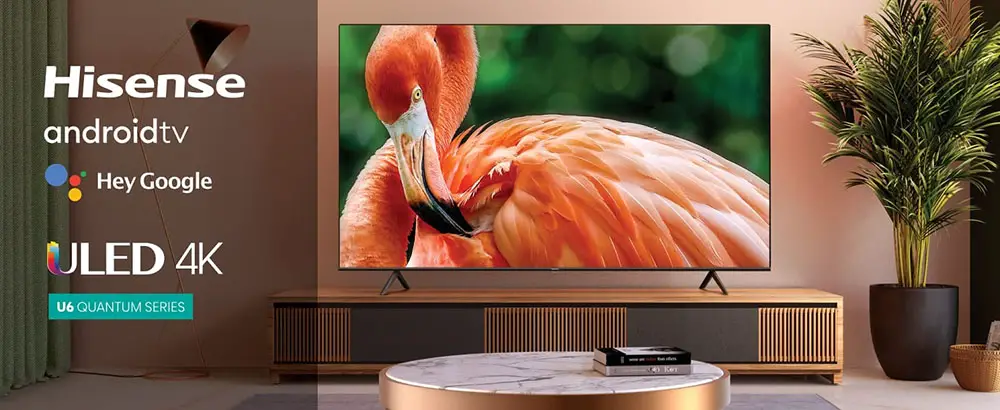
If there is one characteristic with most Hisense TVs that is definitely their value as the Chinese company is aggressively promoting them with prices that is hard for the other big three to compete with. This in theory can give the edge on Hisense and the U6G is a prime example of a TV that offers good picture quality at crazy low price. Yes, the U6G may be missing some key characteristics and features we now see often in 2021 offerings but if you don’t care about them then it can be a great option to consider.
So what does the U6G offers to make it such an interesting proposition? Using a 60Hz VA panel the U6G is one of the cheapest LED LCD TVs to feature a FALD backlight with local dimming while a quad core processor takes processing duties. Unlike the big three Hisense has equipped the U6G with both HDR10+ and Dolby Vision support which is a major plus while Dolby Atmos is also available. Lastly the TV comes with Android TV 10.0 which is the latest 2021 version of it.
With a quick look at the specs the U6G really looks like an interesting release. Are there any catches or Hisense has a real low budget winner here? Let’s find out…
Design
This is the first Hisense TV we are reviewing so we cannot tell if the design has been kept from some other model from the previous years or not. Overall it’s not a bad looking TV if you consider its low budget nature. Being a FALD unit means that its overall thickness is higher than most other edge LED variants as the U6G was measured at around 3″ (7.8 cm). It can still look nice on a wall but will definitely extrude more than some other models.
Its borders and bezels are thin enough and on par to other competing units. Now at the back we find all ports on the right side divided into two groups with one looking sideways and the other backwards. The power connector is kept separately on the left side while on the lower end a special groove can be used for cable management. The lower half of the TV is thicker due to the electronics box and this is where we also find the holes for the VESA wall mount.
The Hisense U6G is using a typical bench type stand. The legs are made out of plastic which can result in the TV wobbling slightly but not so much to risk falling down. The legs sit almost at the edges of the TV so make sure you have a big enough furniture for it. The legs don’t have any special grooves in them as we have seen in so many other variants to help hide the cables while their height should be enough to fit most soundbars below the TV screen without much trouble.
The supplied remote is nothing out of the ordinary but we have to admit that it has more buttons than we would like to see. Nowadays with such smart OS UIs you don’t really need all that buttons that create more of a cluttered design. The one with the U6G comes with a full numerical pad along with six dedicated buttons that unfortunately cannot be re-assigned. These are for the usual Netflix, Amazon Prime, Youtube, Disney+ and also tubi and peacock that we hadn’t seen being used in other TVs before.

The remote is made out of plastic and uses rubber buttons, its feel is in general good and while it is IR based which means it needs line of sight to work it can also be connected through Bluetooth in order to use its microphone and voice commands feature. The remote may not look as premium as some competing brands but it will do what it was meant to and in this price you cannot really ask for much more.
Overall the Hisense U6G is a nice looking TV. The low price do show in certain aspects of the TV but looking at the whole picture we cannot feel disappointed by what Hisense offers in this price category.
Video Quality
Processor technology used
Unfortunately Hisense does not provide any detailed information about the processor the TV is using. The only info we have is that it is using a quad core processor but by using the Aida64 app from the store we see that the processor actually uses four ARM Cortex-A55 clocked at 1400 MHz. It also comes with 2GB RAM and 4GB of internal storage which may seem a bit low but at least you can use some external flash drive to extend its available storage.
As for its capabilities this quad core processor includes the Hi-View Engine 4K, as Hisense calls it, that is responsible for adjusting shadows and brightness for the best results possible.
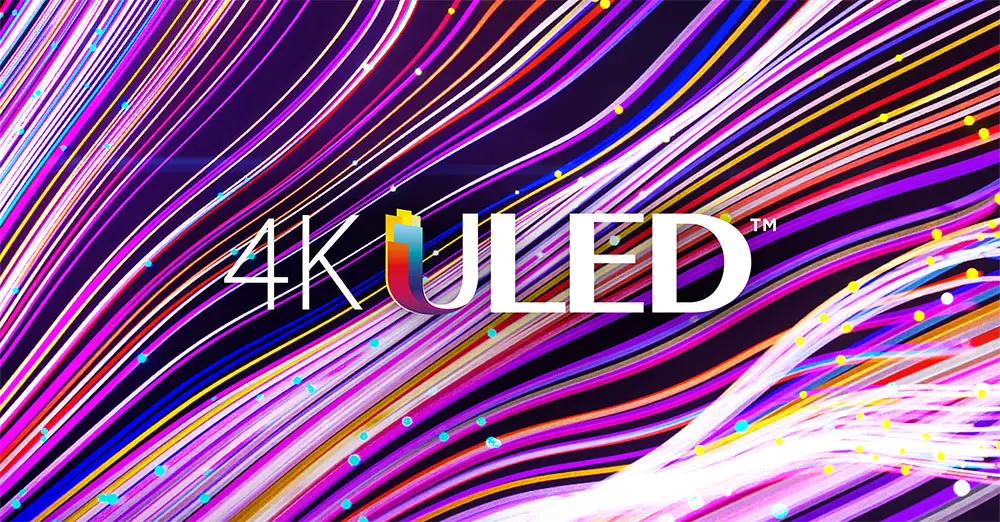
Lighting technology used
The U6G uses a FALD backlight system which may be better than the low end edge LED ones but has been surpassed this year by the new mini LED ones.
A FALD system in order to perform good depends on two factors, the number of dimming zones available and how fast each zone can change it’s light output. The more dimming zones used the better and more accurate light control the TV has but also the higher the price goes, that’s why they usually scale the dimming zones number depending on the model.
The effect on having low number of dimming zones can be seen when you see a very bright object on a completely dark background. If the TV has very few zones light will escape to the nearby pixels and create a visible halo around the object.
Also the light algorithms play a huge role as they control the response time of the various dimming zones. If the change is slower than it should be you will see what is called ghosting when a bright object moves very fast against a dark background.
In the U6G the FALD system is a mixed situation. On the one hand you have a backlight that certainly offers better light control over an edge LED one but the problem here is that there are very few zones for the system to work with. The 55″ model we had for testing is using only 32 zones which are simply not enough to show the real strength of the FALD system. Even the 60 local dimming zones of the 65″ and above sizes are not enough for such a system.
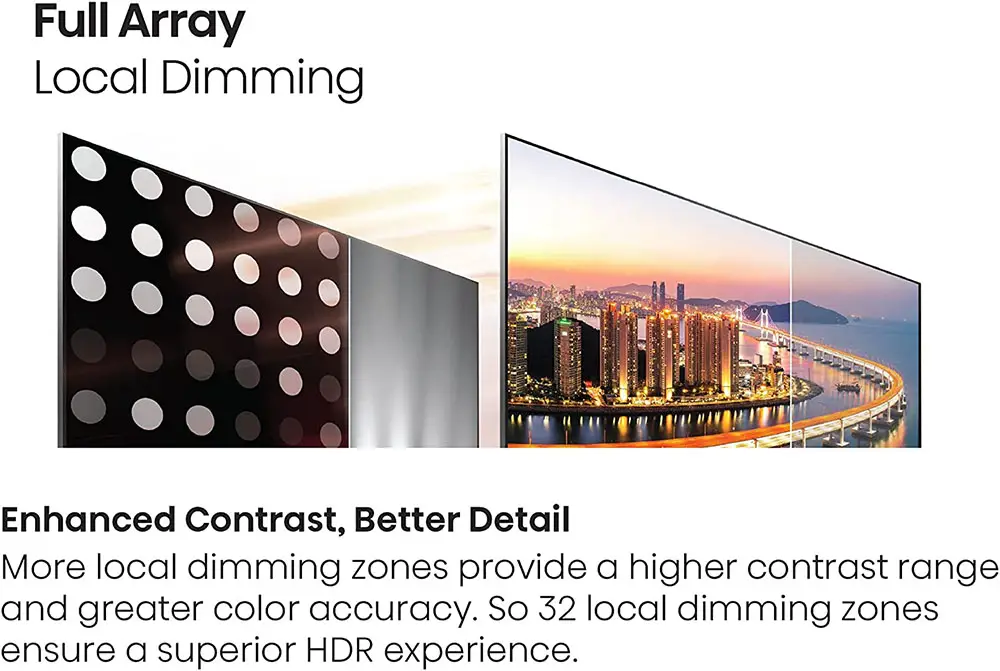
As a result in some demanding scenes blooming was more than obvious, offering downgraded picture quality. Also with a moving object the transition between each zone was more than obvious which can be quite distracting.
All the above left us a bit disappointed. We know how this system can perform but Hisense, in order to keep the cost low enough, had to reduce the number of dimming zones to such low levels that effectively nullified all its obvious strengths.
Brightness / Contrast
One of the most important, but not the only one, factors of any HDR TV is its brightness and this is where LCD technology always exceled at compared to OLED. Hisense is heavily marketing the U6G as being able to hit a 600 nits brightness so let’s see how real this claim is.
For this first part of our review we measured the SDR brightness over a 10% window and the number we got was 615 nits which is great and in fact even higher than what Hisense claims. SDR content does not have high brightness requirements so what the U6G can output is more than enough.
When it comes to HDR brightness over a 10% brightness we measured 627 nits which again exceeds Hisense claims. The TV may not be the brightest we have tested but reaching and exceeding its manufacturer’s claims is a feat by itself. It’s one of the few instances where what is marketed is what you actually get and we applaud Hisense for that.
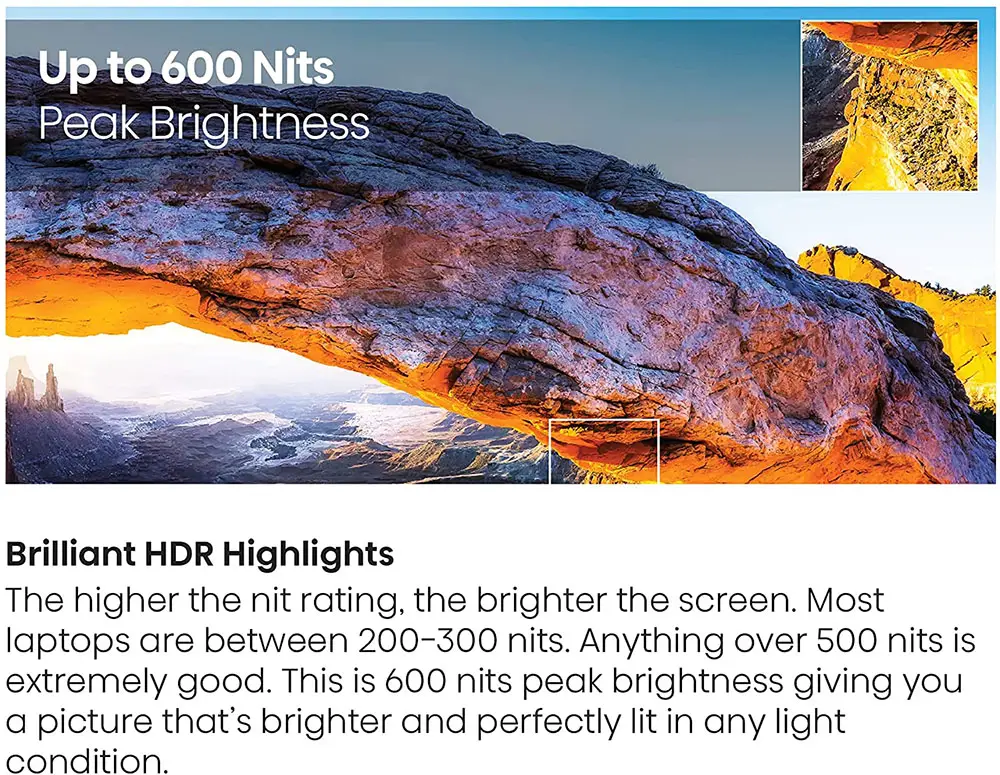
Now 600 nits may not be the best for HDR content but it is good enough considering the low cost nature of the U6G. We did notice some scenes appear brighter than they should but we cannot be certain why this was happening, but as in all our testing we used max local dimming and Backlight settings.
The TV uses a VA panel and as a result contrast was rather good. When you enable local dimming things improve even further but not by much and the difference is not so noticeable as in other TVs.
Viewing angles
Using a VA panel meant that the U6G would suffer a lot in terms of viewing angles. VA panels in general have trouble with this so it’s not a problem of the U6G in particular. Some manufacturers tend to use extra layers in order to improve upon this but the U6G doesn’t seem to be using any similar technology.
As such the best angle we could get out of this one was 25-30 degrees at maximum. Anything more and the image quality takes a dive pretty quickly. As such the U6G is not ideal for family use where many members will be watching at the same time at different spots. But since what is acceptable image quality is very much a personal thing we would suggest you to try it out in a local store in order to be sure if you like it or not.
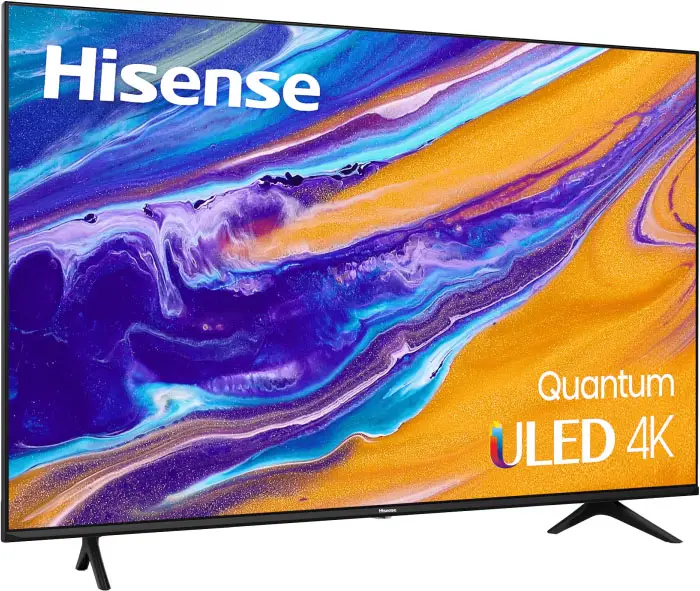
HDR support
With the current HDR war you really have to choose which camp you want to follow as not many brands support all available ones. It’s either Samsung’s HDR10+ or Dolby Vision that Sony and LG support which is really a shame as we don’t get the chance to choose all of them at any time. Thankfully Hisense is one of the few brands that are not supporting any specific camp and instead went ahead and added everything in their releases.
As such the U6G supports not only the basic HDR10 but also HLG which is used for streaming content and both HDR10+ and Dolby Vision which use dynamic metadata for a much better image quality outcome. This is a huge one in our books. Not being bothered to choose between a specific HDR protocol surely opens up much more high quality content. And while HDR10+ content is still much less than Dolby Vision one we are seeing more and more content becoming available. And with Samsung’s support, be certain that even more will come in the future.
Color coverage
Next we will be looking at the colors performance as the U6G obviously supports wide color gamut and can display more vivid and lifelike shades. This is possible as the TV comes with Quantum Dot technology which many high end TVs are using in order to increase the number of colors that can be displayed on screen.
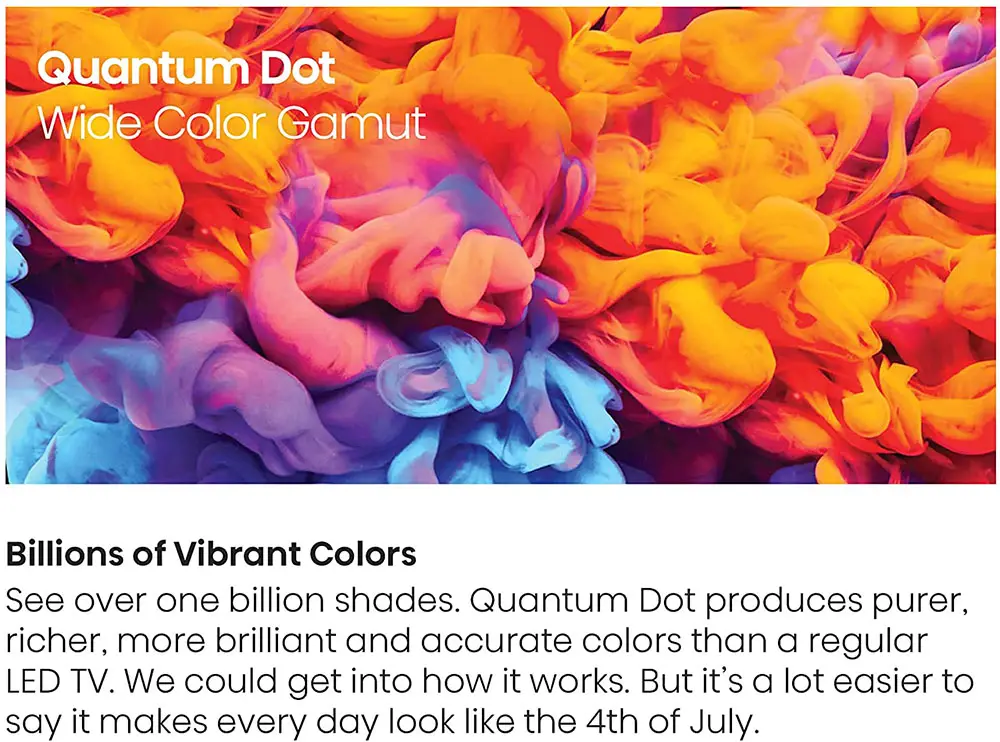
According to our measurements the U6G covers about 95% of the DCI-P3 color space which is really good for its price. On the wider REC.2020 color space we got 72% coverage and once again very good numbers all things considered.
In terms of gradients the U6G handled everything very nicely with only slight banding in some darker shades. Overall excellent behavior here.
Motion performance
The U6G comes with a 60Hz panel which certainly has a negative effect on the TV’s motion performance. The TV is missing a motion interpolation feature although, strangely enough, the manual mentions it. There is a note in the manual claiming that some models are missing this feature so it seems that Hisense has stripped this feature from this unit.
At least we do get Black Frame Insertion (BFI) which basically is a motion interpolation technique that inserts a black frame between every two individual frames and this can really create much smoother motion. But while the end result is pretty good there are some downsides to this with the most obvious being the lower brightness being displayed due to the black frames. In the U6G another problem we detected with BFI was very obvious image duplication due to crosstalk. As such the end result is a mixed bag when using BFI and not the clear improvement we were hoping for.
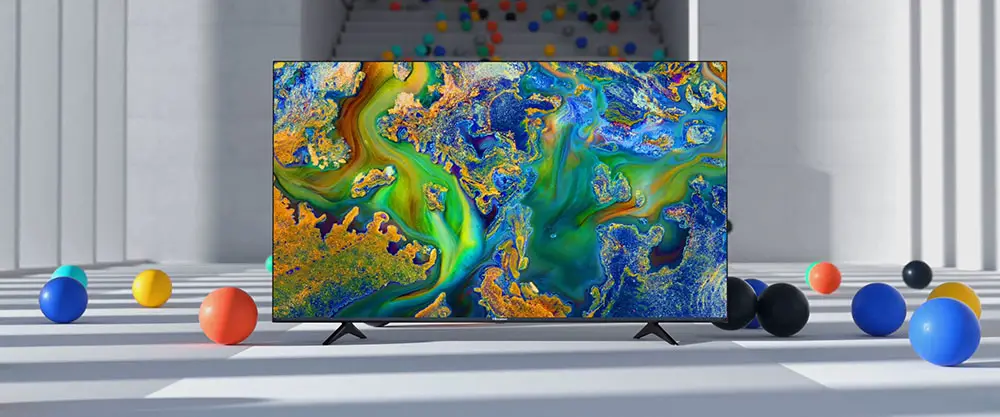
Lastly as there are no HDMI 2.1 ports it was natural that the U6G would be missing VRR altogether. Overall we cannot say that motion performance disappointed us but you shouldn’t expect anything more than the basics from such a low priced model.
Input lag
The Hisense U6G displayed a similar behavior in terms of input lag as most modern TVs do nowadays. As such a 10.1ms input lag average was measured in both 1080p and 4K resolutions which is excellent and will satisfy even the most demanding of gamers. With such a low input lag gaming can really be a pleasure but in order to get such a low value you have to keep in mind that you need to use the available Game mode.
And while the number we got was great what surprised us was the input lag we measured outside of Game mode which averaged at 44.5ms. This must be the lowest input lag we have measured across all brands outside of Game mode. Although we don’t know what Hisense has done in order to get this, we suspect that a minimal amount of image processing may be what allows the U6G achieve such a number.
We should also not forget to mention that the TV supports Auto Low Latency Mode (ALLM) that can be used with any devices that support that like the PS5 and Xbox consoles and can greatly benefit users. Unfortunately there is no HGiG mode available here.
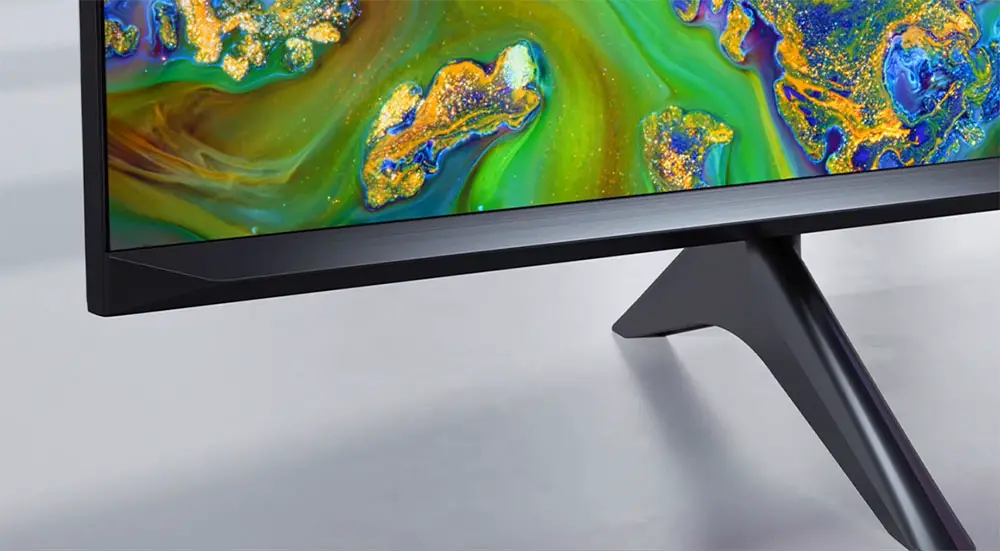
In order to get a real feel of the TV’s capabilities we connected our PS5 and used our copy of F1 2021 for a spin. The U6G may be lacking some features but to be honest its low input lag and fast response times makes this an excellent gaming TV. All our commands rendered immediately on screen with no delay at all resulting in a very smooth and pleasing gaming session. For the price asked the U6G did really great here.
Image quality impressions
Well, the Hisense U6G is clearly not a high end model and you should expect image quality that will reflect that. On the one hand it is nice to find a FALD backlight in such a low cost unit, its upscaling capabilities were good enough, color reproduction was great, input lag was amazingly low and brightness, although nothing spectacular, was as much as the manufacturer claims. If you add to the above the inclusion of both HDR10+ and Dolby Vision along with Filmmaker mode you get decent performance for the price asked.
But it’s not exactly smooth sailing. The extremely low number of dimming zones available makes the FALD backlight not as good as it can really be resulting in noticeable blooming. Transitions between the zones is also more obvious that we would like while viewing angles were not good at all. Motion performance was ok but nothing special to talk about while it certainly misses a few gaming features like VRR and HGiG mode.
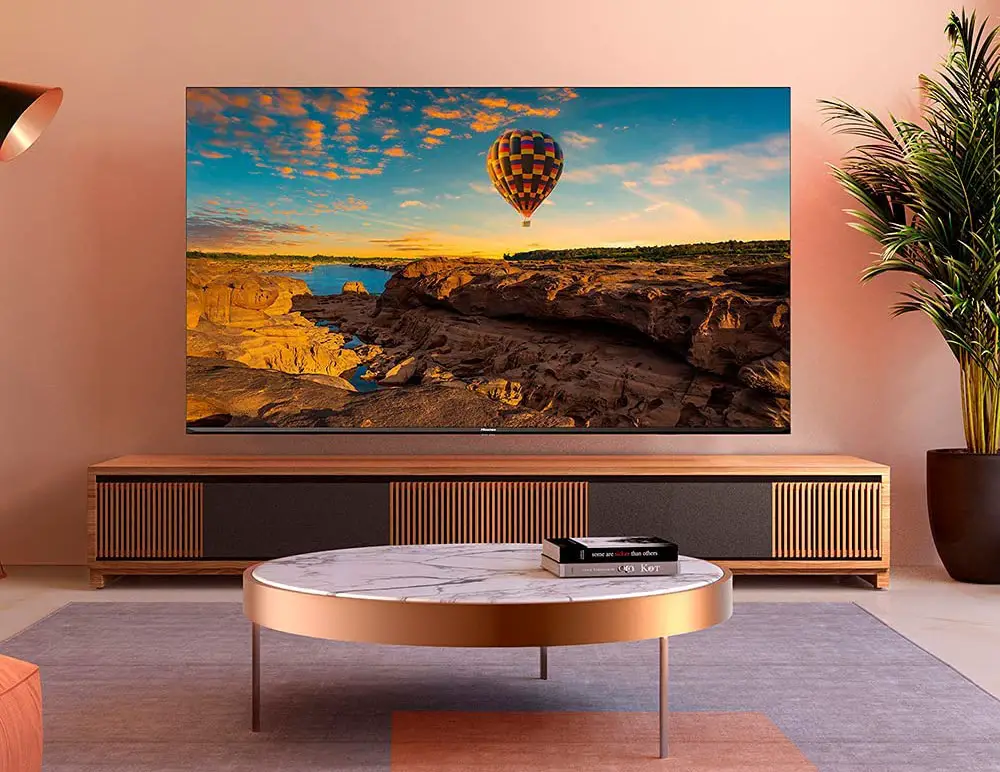
In the end everything should be judged compared to its cost and we can say with the price asked the TV really offers a lot of value that is hard to find in this category.
Audio Quality
Next in line is sound performance and from what we see the U6G features a pretty standard 2.0 channels audio system with a total of 20 watts of power (2 x 10 watts) which is the normal for this category. The included system is adequate for casual viewing but in general it cannot offer anywhere near the kind of immersion of a surround system.
There are a few sound modes to choose from but they don’t make a lot of difference to be honest. You also have the ability to output either from the TV speakers, through the ARC connection or even to some Bluetooth enabled speakers.
The U6G seems to support Dolby Atmos but we didn’t see much difference when we turned that one on. Yes, there was a slight change in dynamics but overall sound was still swallow and flat and didn’t have any volume to it to create a deep 360 degrees soundstage. The hardware is simply not capable enough for Atmos support.
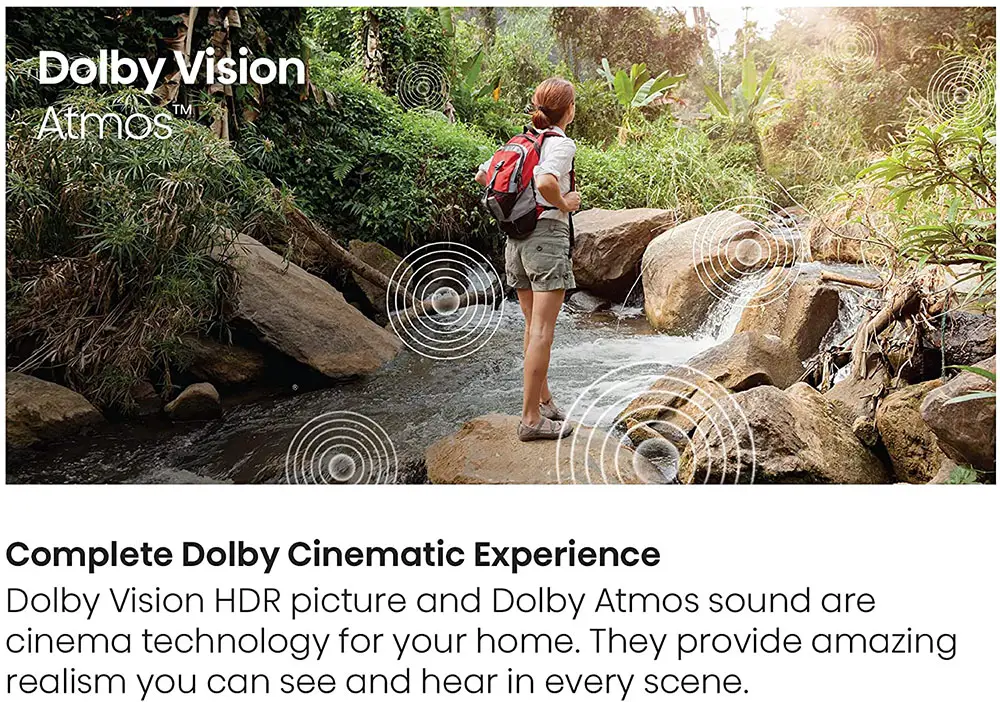
Also while the TV can get loud enough, pushing it to higher levels revealed some distracting distortion that threw everything out of balance. In normal listening levels sound came good enough with clear dialogue and much better stability.
We can’t say we were expecting anything extraordinary here. The TV already did much more in the image department than its price would make you believe so it was obvious that sound would take a backseat. It is adequate for casual use but for anything more you better get at least a soundbar if not something better.
Ports and Connectivity
As we mentioned above the U6G comes with two sets of ports located at right side of the back panel. Those looking sideways include three HDMI ports, an optical digital output, two USB ports and the antenna/cable connector. At the other group we find a fourth HDMI port, an Ethernet connector, one headphones mini jack and another one for service and lastly analog ports including stereo audio inputs and a composite video input.
A few notes about the ports now. First of all keep in mind that the U6G does not come with any HDMI 2.1 so if that is important to you then you will have to look at a more expensive offering from Hisense. All of them are HDMI 2.0 meaning they can handle a maximum of 4K@60Hz. Also there is no eARC available with only a single HDMI port supporting the older ARC. With it you can pass-through not only Dolby Digital but also DTS signals to an outside audio device.

Also the USB ports are the older 2.0 and although these shouldn’t have a problem with most files we would like to see at least one USB 3.0 available. Lastly this is one of the few 2021 releases that still has analog ports available so if this is really important to you the U6G is one of the choices you have.
As for the TVs wireless capabilities we get built-in WiFi (802.11ac) along with the Bluetooth although it is not mentioned anywhere which version the TV uses.
Overall a pretty decent layout for the price asked. HDMI 2.1 may be kept for more expensive TVs but we were at least hoping to get eARC which we didn’t.
OS, Apps and Features
Hisense has been using the Android TV platform for their TVs but unlike Sony that switched to the Google TV interface, Hisense decided to use the standard Android TV platform once again. And in 2021 we have reached Android TV 10.0 which is not all that different from last year’s edition in terms of usage and UI presentation.
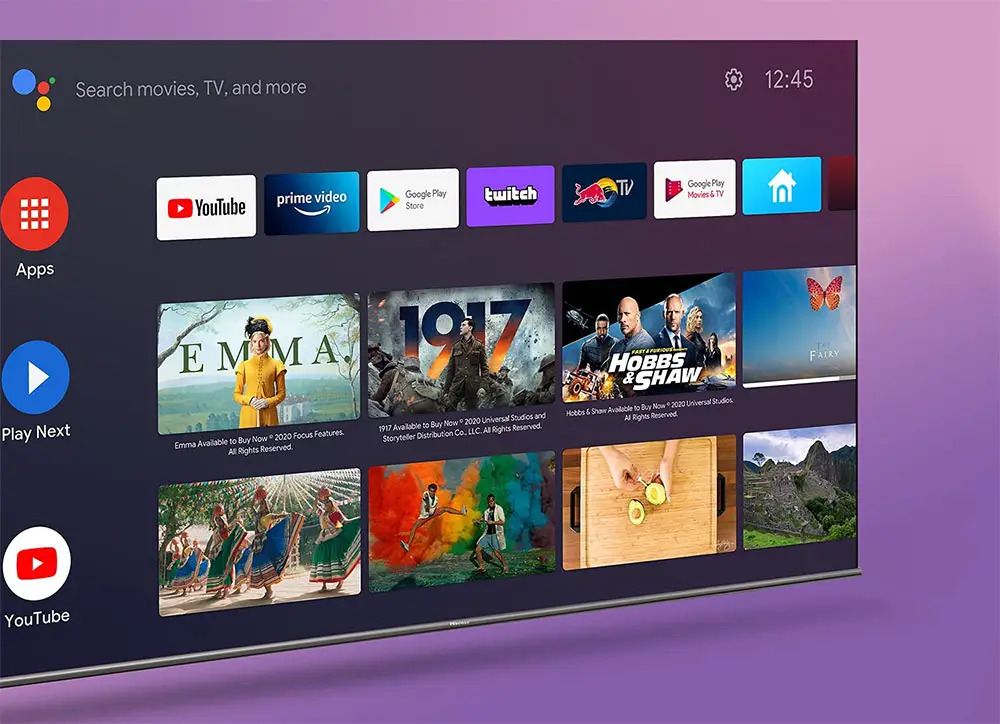
Unlike webOS and Tizen the Android TV platform takes the whole screen when you enter its home screen and you get various selections on the top and left of the screen. Customization is also possible in certain parts of the layout that could help you organize various tiles and icons to your preference.
With the latest Android TV 10.0 version we had a very smooth and lag free experience across all its menus and UI settings. Everything run fast and we didn’t experienced any unusual bugs at least during the time of our testing. Opening and closing the various apps was very smooth and will not keep you waiting a lot.
If there is one thing that Android has in abundance that is definitely the huge support from developers. Through the included Google Play you can find literally thousands of apps that you can download and use except from the pre-installed ones. There is so much content available that you will definitely find the ones you are looking for and the list goes on and on.
Some of the most prominent names are all accounted for including Google Play TV & Movies, Disney+, Netflix, Amazon Video, Sling TV, Hulu and Youtube as well as Pandora, Tidal, Google Play Music, Spotify or iHeartRadio. As always some of them are region dependent so make sure the ones you are interested in are working in your area.

Chromecast is also available here and it gives you the ability to stream content from other Chromecast enabled devices like mobile phones and tablets directly to the TV. Voice control is also present but it seems that it is a bit limited compared to other competing models. By that we mean that although you can use the remote’s built-in microphone to give commands to Google Assistant for Amazon Alexa you will need an external Alexa enabled device to work.
We have seen the same thing in some other Sony TVs that were using Android TV also and probably has to do with the fact that it’s using Google’s Android system and thus having Alexa built-in was not possible. With voice control you can issue various commands to the TV but functionality extends far beyond that as you can control any smart devices you have in your house also.
There is also a built-in media player available that you can use to playback various video and audio content from an external storage connected to the USB ports. Although this supports many frequently used files like .avi (XviD, Mpeg2, H.264), .mkv (H.264, H.265), .mpg (Mpeg2), .ts (H.264, H.265) overall its capabilities are lacking compared to some other built-in media players from competing brands. Also in terms of audio it can only playback mp3 files.
There is not much more you can find in this TV in terms of extra features showing that some key missing features were necessarily taken out in order to keep the low price. Many people simply do not care about having all these extras so if you are one of them then the Hisense U6G is certainly a great deal.
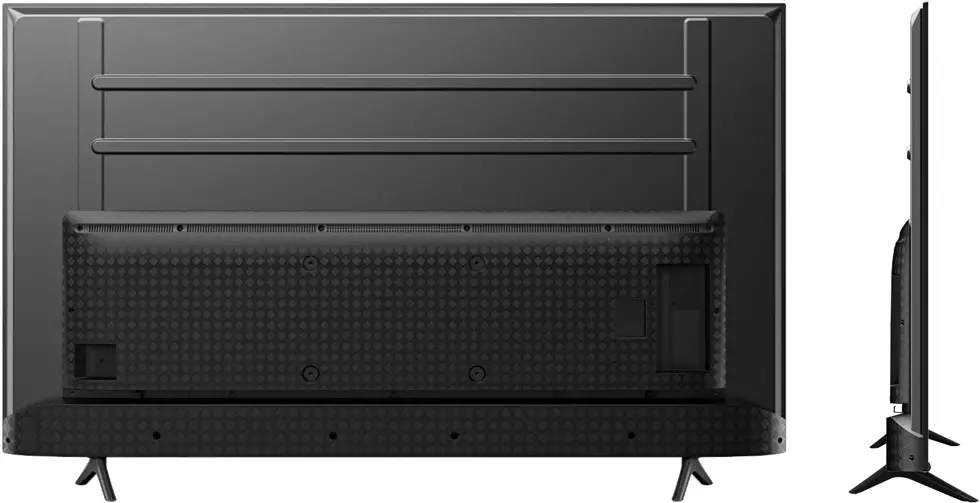
Final Thoughts
This was our first experience with Hisense and overall we can say that we are very happy with what we saw in comparison to its price. Hisense really put a lot of focus on creating a TV that would offer respectable image quality first and foremost and in a price that is almost unmatched by any rival brand. The U6G may be missing many extra features that we find in higher priced units but in the end it’s what you are looking for that will determine its value and if image quality at extremely low cost is your thing the U6G is an interesting proposal.
The TV has a lot to offer to be honest. Great upscaling capabilities, amazing colors and gradients, good brightness in both SDR and HDR, excellent input lag both in and outside of Game mode and support for not only HDR10+ and Dolby Vision but also Filmmaker mode are some of its real strengths. Add to these its nice design and mature Android TV 10.0 and you have a recipe for success.
On the downsides the FALD backlight has too few dimming zones to work with resulting in blooming and slow zones transitioning, viewing angles are bad as with all VA panels and motion performance, although not bad, it was nothing great to speak of. Also its sound system cannot do anything more that the basics while there are no HDMI 2.1 ports which lower its capabilities as a gaming TV. Lastly the included Android TV is missing a few advanced features found in more expensive releases.
Closing our review we can say that the Hisense U6G has a lot of value for the price asked. If you are looking for a low cost TV that has respectable image quality and you want it for mixed use this one certainly fits the bill. Don’t expect any miracles in terms of image quality but in this price range there is hardly anything that can compete with it and this is a great achievement on Hisense’s part.

For more reviews you can check our dedicated 4K LED LCD TV reviews list or even look at our Product Reviews Table where you can find the brand and specific product you are looking for.
Cheapest Places to Buy :
*We are a reader-supported website. When you buy through links on our site, we may earn a small affiliate commission at no extra cost to you. Home Media Entertainment does not accept money for reviews.*
Hi Stratos
I had a Hisense TV before and I cannot say I have the best of experiences. Picture quality was not as good as I would like it to be but seeing how cheap the U6G is has made me consider giving them another chance. I will certainly try to see it from close myself.
Regards
Steve
Hey Steve. It really depends on what you are expecting out of it. Because it has a FALD backlight doesn’t mean that it doesn’t have some very obvious problems. I agree that seeing it from close to determine by yourself is the best course of action.
I was looking for a low cost TV as I need one for my living room and saw the U6G in a retailer. It’s no so bad considering the cost, I think your review is spot on with how the FALD system behaves. Blooming was indeed obvious but considering what you pay for it, it didn’t bother me. Nice review you did there!
Hello Alicia. Indeed the FALD backlight does have problems but the U6G must be one of the cheapest TVs that come with one so having it with this cost is an achievement by itself.
Can we get some hdr picture recommendation settings ? 🙂
Hey there. From my notes the HDR Theater mode was the most accurate one.